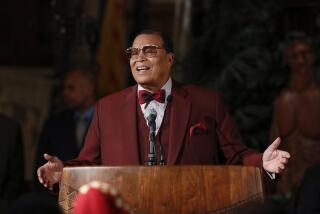HUMAN RELATIONS : Center Seeks to Heal Rift Between Blacks, Jews : Onetime allies have been split by such issues as Farrakhan and Israeli aid to South Africa.
- Share via
NEW ORLEANS — Here on the serene and lushly green campus of Dillard University, Samuel DuBois Cook is beginning the process of healing.
“For too long now, two of the most important segments of the civil rights community, blacks and Jews, have been divided,” said Cook, president of the private, predominantly black Dillard since 1975. “Hopefully, what we’re about to do will greatly erase those divisions.”
He was talking about the formation of the National Center for Black-Jewish Relations at Dillard, the first such center of its kind in the nation.
Cook, a longtime educator who was once Dr. Martin Luther King Jr.’s classmate at Moorehouse College, said the two groups “should have never come apart in the first place.” He said the center, which has been given a $100,000 operational allotment by Dillard, will be dedicated to fostering communication and understanding between them.
But the former civil rights activist, known in New Orleans for his devotion to humanitarian causes, admitted that the task won’t be easy.
“There have been great differences between our two communities on matters of public policy in recent years,” he said. “Sometimes, there’s even been meanness and viciousness. We have our work cut out for us.”
Although some historians date the black and Jewish alliance to the 1920s, when both groups rubbed shoulders in trade union and early civil rights efforts, recent times have not been kind to the old coalition. Many Jewish leaders, for example, have expressed outrage over the anti-Semitic rhetoric of Louis Farrakhan, the leader of the Nation of Islam, and anger at the Rev. Jesse Jackson, who in 1984 referred to New York City as “Hymietown.”
Blacks, meanwhile, have reacted with anger to some conservative Jewish charges that affirmative action promotes reverse discrimination and to Israel’s military support of South Africa’s apartheid government.
With the center’s formation, however, Cook hopes to reverse recent trends and “rediscover the many important things we have in common.” So far, his idea has received an enthusiastic response.
“Samuel Cook is a dear, sweet, gentle man,” said A. I. Botnick, executive director of the south-central region of the Anti-Defamation League of B’nai B’rith. “And, if we have a chance to talk frankly and honestly about where we were, how we drifted apart and how we can make positive changes to reunite, I think it’ll work.”
Shirley Porter, director of the National Assn. for the Advancement of Colored People in New Orleans, is equally hopeful: “We have to remember our commonality, how we’ve worked together before, how both our groups have religious backgrounds and are deeply rooted with our families. The more we talk with one another, the more we discover how important it is for us to get back together.”
But Porter said some polarization between the two communities will never completely evaporate, citing Jewish animosity toward Farrakhan, whom she said “many of us cannot completely denounce because he has also done a lot of positive things for us, such as walking into ghettos and inspiring young blacks to get off drugs.”
Ironically, the study center, which will hold annual conferences on common issues and coordinate joint community projects, was given a boost this fall by the unsuccessful campaign of former Ku Klux Klan Grand Wizard David Duke to become a U.S. senator from Louisiana. Black and Jewish activists in the state combined forces to defeat Duke, said one Jewish volunteer, who added: “It was the first time in a long time we’ve seen how wonderful it is to be united. That’s why a center like this can only help.”
Cook has a goal of eventually raising up to $10 million to endow the center. He has made several trips to Israel, speaks easily about the spiritual and religious links connecting blacks and Jews and says his greatest goal is to enlighten the young.
“That’s the group we must most concern ourselves with, that’s where some of the greatest misunderstandings have occurred,” he said. “I’d love to see students, Jewish and otherwise, from predominantly white schools and students from predominantly black schools get together here and listen to one another. We want to see a healing begin, and the best place to start is with the young.”
More to Read
Sign up for Essential California
The most important California stories and recommendations in your inbox every morning.
You may occasionally receive promotional content from the Los Angeles Times.













